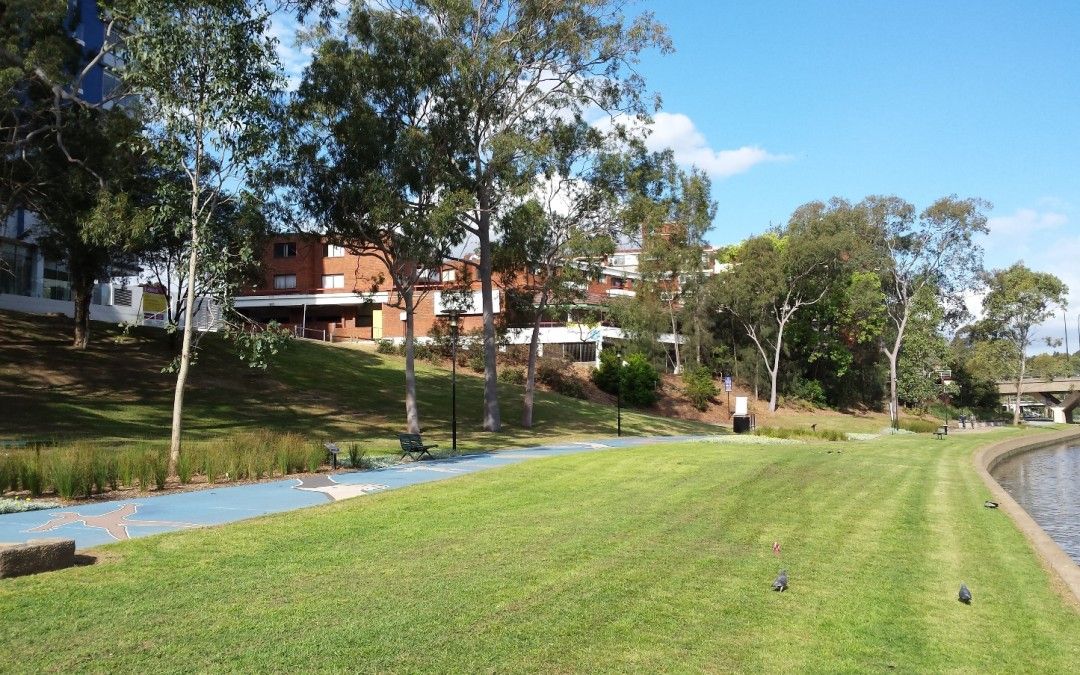
Riverbank at the end of Sorrel Street looking North East, photo by G. Barker, 2014
Surgeon John White in his Journal recounted his exploration of the Parramatta River in 1788. On the 24 April he records … Just above this flat, close to the water-side, we discovered a quarry of slates, from which we expected to derive great advantage in respect to covering our houses, stores &c., it being a material beyond conception difficult to be procured in this country; but on trial it was found of no use, as it proved to be of a crumbling and rotten nature.
It seems White mistook the soft shale on the riverbank for a deposit of much harder slate but there was an upside to this discovery. Shale crumbles when it is wet making it a reasonable material for brick making. By contrast when shale is heated, say by volcanic action, it is transformed into the more durable rock called slate. Because of the presence of the mineral mica, it cleaves well and is very suitable for the covering of roofs.
Historians and writers have often mistaken this ‘quarry’ of shale for the cliff of shale just west of the northern approaches to the Gasworks Bridge. This site was along the northern bank between the foot of Sorrell Street and the Lennox Bridge.
When Bradley was dispatched with Captain Hunter in May 1788 to examine the ‘slate’ deposit. He wrote … A party went up the harbour to the lake or creek running to the north west above the flats. We went about three miles up to a very fine run of water; … a little above the point where the fresh water meets the tide is the place supposed would produce slate, but had been found on examination not fit for working: We tried it as coal without success.
This boat trip by Bradley was the first recorded exploration of the river beyond the Silverwater Junction. Assistant Surgeon George Worgan, surgeon of Sirius, was a member of the party on this day and he described it as a ‘most delightful excursion’ … We landed quite up at the head of this branch where a fresh water river runs into it, but which at this time was dry in many places. We walked about two miles up the country in the direction of this river; …Having extended our excursion as far as we wished, were turned to the place where we landed and after regaling ourselves with a cold kanguroo (sic) pie and a plum pudding, a bottle of wine etc, all which comforts we bought from the ship with us, we returned on board.
The shale band at the foot of Sorrell Street seen by the explorers has long since disappeared as it was dug out and used for brick making in the earliest days of settlement. This area is now part of the reclaimed edge of the riverbank ‘training wall’, now called Riverside Park. There was possibly a stone quarry here also to service the building of the second gaol.
On the site now occupied by the Heritage Centre at the northern approach of Lennox Bridge, there was a workshop owned by the builder/architects James Houison and Nathaniel Payten.
Around the middle of the 1800s Peisley’s Slaughter House appeared just to the east of this site on the north bank . Tom Little, a Parramatta printer recalls the building in the 1860s, jutting out over the river, discharging waste into it. It could be assumed that this became a job for the Inspector of Nuisances of the newly formed Borough Council.
References
The ‘quarry of slate’ was really shale; J. White, Journey, p. 128.
W. Bradley, Voyage, p. 160.
G. Worgan, Journal of a First Fleet Surgeon, Sydney, LAH and Library Council of NSW, 1978, p. 45.
B. Freeman, Time to Tell
J C Wharton (ed), Jubilee History of Parramatta, 1911, Parramatta, Cumberland Argus Printing Works, 1911, p. 43
![]() John McClymont, Parramatta Historian, from unpublished manuscript, Parramatta City Council Collections, 2014
John McClymont, Parramatta Historian, from unpublished manuscript, Parramatta City Council Collections, 2014


